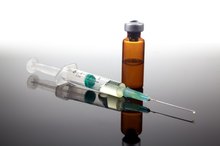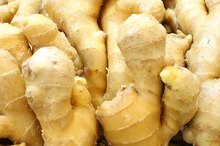What does fact checked mean?
At Healthfully, we strive to deliver objective content that is accurate and up-to-date. Our team periodically reviews articles in order to ensure content quality. The sources cited below consist of evidence from peer-reviewed journals, prominent medical organizations, academic associations, and government data.
The information contained on this site is for informational purposes only, and should not be used as a substitute for the advice of a professional health care provider. Please check with the appropriate physician regarding health questions and concerns. Although we strive to deliver accurate and up-to-date information, no guarantee to that effect is made.
How to Dissolve Blood Clots
Blood clots, which are cells that have joined together, are often dissolved naturally within the human body. However, those that aren’t dissolved can cause restriction and pain. Worse yet, their movement can result in serious ailments like heart attack or stroke. Conditions resulting from blood clots kill thousands of individuals all over the world each year. For that reason, medical research continues to explore ways to dissolve blood clots in order to head off life-threatening situations.
If you are experiencing serious medical symptoms, seek emergency treatment immediately.
Wear compression hosiery to keep new blood clots from forming or old ones from growing larger in the legs, leading to vericose veins. According to Planet RX, although there is debate over whether or not such hosiery actually helps break up clots, erring on the side of caution is generally advised.
How to Get Rid of Blood Clot in Finger
Learn More
Use a combination of hot and cold packs, along with elevation, to prevent blood clots from forming as a result of a bodily injury. According to Your Total Health, keeping damaged limbs elevated will help reduce the swelling, which could lead to clot formations. Heat packs help dissolve clots that form close to the skin naturally while cold packs help keep swelling down and reduce pain.
Take one tumeric tablet or drink tea laced with one teaspoon of tumeric with each meal. According to several alternative medicine sites, including Right Health, many medical researchers believe that the spice is helpful in dissolving blood clots.
Vitamin K & Heparin Overdoses
Learn More
Take a prescribed blood thinner, known as an anticoagulant. According to the American Heart Association, these drugs work well to prevent the blood from being able to clot too easily 1. Even after a clot has formed, anticoagulants can prevent it from getting larger and lodging in the body, causing temporary or even permanent damage.
Take an antiplatelet drug like aspirin daily to prevent blood from easily combining together to form a clot, according to the American Heart Association 1.
Consider a vena cava filter. Implanted by a physician, it filters out particles that activate the clotting process, thus preventing clots from forming and making their way into the lungs, resulting in pulmonary embolism.
Submit to an IV treatment of a thrombolytic medication, sometimes referred to as a clot buster. According to Discoveries in Medicine, this technique is used whenever the blood clot is unusually large, causing the patient extreme and undue pain, if the clot is obviously moving rapidly through the body, or if heart attack has already happened.
Undergo a catheterization to introduce a thrombolytic enzyme directly into the clot or to remove the clot altogether. This is often the preferred method for stroke patients, according to Discoveries in Medicine.
Take a tissue plasminogen activator to dissolve the clot. These can be very expensive and are not widely available. However, according to the American Heart Association, these drugs specifically target the clot site to work on dissolving the clot before it has time to move or grow larger 1.
Tips
Compression hosiery begins at the arch of the foot and goes up to the knee. Tumeric can be purchased in herb, powder, tincture or tablet form at many health food stores. Blood thinners typically come in pill form for at-home use. However, they may be injected directly into the body or through an IV in a doctor’s office, clinic or hospital. Heprin and warfarin are two commonly prescribed blood thinners. Blood-thinning treatments may be short or long term in nature, depending on the disease or medical conditions involved. Thrombolytics are generally only used when all other treatment types have failed and the patient’s life is in danger. Most thrombolytic treatments, whether IV or via catheter, are followed up with the introduction of anticoagulant medications to prevent additional clots from forming. Tissue plasminogen activators are produced in human blood but only in extremely small amounts. Researchers are working on cloning animals to produce the activator in larger amounts to make it easier to locate and cheaper to use.
Warnings
Blood thinners can make it difficult for those with other bleeding issues like ulcers and, therefore, may not be recommended for all patients. Always inform your physician prior to any operation if you are taking a blood thinner as it may affect the surgery significantly. Inform your physician of any natural or prescribed drugs that you are taking.
Related Articles
References
- The American Heart Association has information on blood blots and heart attack.
- For detailed information on blood clots, visit Discoveries in Medicine.
- National Heart Lung and Blood Institute. Venous thromboembolism.
- National Blood Clot Alliance. Blood Clot Treatment.
Tips
- Compression hosiery begins at the arch of the foot and goes up to the knee. Tumeric can be purchased in herb, powder, tincture or tablet form at many health food stores. Blood thinners typically come in pill form for at-home use. However, they may be injected directly into the body or through an IV in a doctor's office, clinic or hospital. Heprin and warfarin are two commonly prescribed blood thinners. Blood-thinning treatments may be short or long term in nature, depending on the disease or medical conditions involved. Thrombolytics are generally only used when all other treatment types have failed and the patient's life is in danger. Most thrombolytic treatments, whether IV or via catheter, are followed up with the introduction of anticoagulant medications to prevent additional clots from forming. Tissue plasminogen activators are produced in human blood but only in extremely small amounts. Researchers are working on cloning animals to produce the activator in larger amounts to make it easier to locate and cheaper to use.
Warnings
- Blood thinners can make it difficult for those with other bleeding issues like ulcers and, therefore, may not be recommended for all patients. Always inform your physician prior to any operation if you are taking a blood thinner as it may affect the surgery significantly. Inform your physician of any natural or prescribed drugs that you are taking.
Writer Bio
A business and education specialist for 30 years, Chantel Alise also owned a management and marketing training company. She has written newsletters and training manuals as well as business articles for Enid News and Eagle's Business Journal. She is principle writer for Beauty Biz. Alsie attended Thomas Nelson Community College (Virginia) and Phillips University (Oklahoma).









